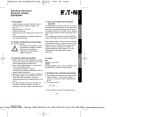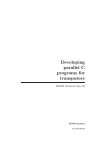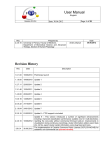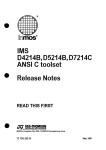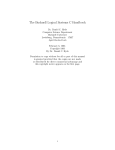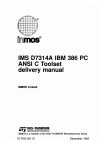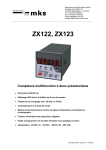Download A Small Parallel C Simulator
Transcript
A Small Parallel C Simulator Manuel Mollar Depto. de Informatica Universidad Jaume I Aptdo. 242, 12071 Castellon, Spain Abstract The C language is an interesting choice for parallel programming with the transputer. We present a module built in C that allows a program written in INMOS Parallel C to be run in any computer with minor changes, using a sequential compiler. Only the language is simulated, not the architecture, providing fast execution and reasonably accurate timing. 1 Introduction. Our simulator allows the compilation and execution of parallel programs written in Parallel C using our favorite programming toolset in the corresponding computer. The main goal is the simulation of the language, not the architecture. In consequence, the debugging facilities will be those of the programming tool, so the training e ort is minimum. In short, the main advantages of the built simulator are four: debugging facilities, high execution speed, deadlock detection and the possibility of running without the transputer hardware. It has been written in ANSI C to guarantee portability. After having developed it using the Borland C IE on a PC-clone, it has been compiled under HP UX without any change. In x2 we describe the simulation guidelines and give some de nitions, in x3 and x4, the necessary changes to program source are described. In x5 and x6 the basic simulation strategy and algorithms are given, showing the debugging possibilities in x8 and x9. In x7 we explain the available multiprogramming features. 2 The simulation. The simulator is constructed as two include les and one module that must be linked with the parallel program. It provides the routines for communication, and a transparent concurrence mechanism to simulate the parallelism. The chosen concurrence strategy is based in a co-routine scheme built using the setjmp C package. Of course, a round-robin scheduler would be more realistic, but the diculties and the loss of portability are evident. Furthermore, most debuggers will not run with this scheme. Co-routine based concurrent execution is far from the behavior of the parallel program. However, once the transfer strategy has been understood, the sequential trace of the program is very convenient for a good tracking of the parallel algorithm. For every processor, the simulator distinguishes (and can compute) among Total Time (TT), Input Waiting Time (IWT), Output Waiting Time (OWT), Communication Time (CMT), and Computation Time (CPT). Last one is the employed by the sim- ulating processor (in all that follows, the host processor) in executing any no-communication instruction. A scale factor is computed to return the real transputer times (T805). The communication costs (CMT) are estimated with a usual theoretical model: estimate the cost of the link set up and the cost of the transmission of one byte. The total cost is: cost of set up + cost per byte * no. of bytes. Both can be manual or automatically adjusted. Setting them to 0,0, the simulator will show the degree of parallelism of the algorithm. The communication costs are only accounted in the processor that does the output operation (in all that follows, the output processor); in the input processor, it is accounted as Input Waiting Time, de ned as the time from the input operation request to its completion. By Output Waiting Time we designate the expired one from the output request till the input operation beginning. Always, we know the Total Time per processor, so the maximumone is the time of the parallel algorithm. We also know the total computation time, as the addition of the Computation Time of every processor. Then, the simulator can compute the speed up of the algorithm for any given number of processors respect to the same algorithm executed in one processor. In the simulation, a processor executes its code sequentially until it requires to communicate with another. Depending on the situation of the other, execution is transferred to it. The transfer routine ac- counts the expended CPU time. The algorithmic effort is centered in the communication routines, as we will explain. The number of physical links in the transputer can be extended in the simulation to any number. So, an algorithm designed for a n-cube that runs directly in the T805 transputer for n = 1,2,3, can be tested for any value of n, to prove its correction, simply increasing the number of links at con guration time. 3 The tailored program. In the transputer system, con gured executable code may be constituted by di erent programs for the di erent processors [1]. Now, by evident reasons, only a program can be present. The solution is that each simulated processor executes a routine of the tailored program. This routine does not need to be di erent for every processor, the con guration mechanism allows to allocate the same routine for several processors. Thus, the rst tailoring operation is to join the original programs into a single one, maintaining the multiple le structure, if desired. To do it, all the main routines must be renamed. Then, a new main routine must be created, intended to con gure the network and to start the simulation. To avoid the construction of a parser for the les accepted by icconf [1], the simulator includes a set of routines that implements the con guration task. The joining process has a drawback concerning to global variables. Suppose that in the transputer network con guration, a program must be shared by several processors. In the tailored code, we want to allocate the same routine for these processors. Then, all the global variables from the original program must be converted into local ones to the renamed routine. The presence of global data in the tailored program implies the simulation of a shared memory. The only alternative is the replication of the variables, with the corresponding naming task or the inclusion in a vector, but this is not a serious approach. To avoid having a program for the simulator and others for the transputer, we can use the C preprocessor. Using the #ifdef directive, code can be tailored at compilation time, using the appropriate de nitions. For example, suppose that we want to run a program in processor 0 and another in the rest of processors. We can write the code for a single le like this: Here the headers for all the processors = #ifndef procR = Here special headers for processor 0 = #endif #ifndef procR #ifdef proc0 int main() #else void RoutineFor0 () #endif = Here the code for processor 0 = #endif = #ifndef = #ifndef proc0 #ifdef procR int main() #else void RoutineForRest () #endif = Here the code for the rest of processors = #endif = #ifndef = #ifdef InSimulator void main() = Here the code for con guring = #endif = In this example, for the real machine, we must de ne proc0 at compiling time to generate code for processor 0, de ne procR to generate code for the rest of processors. When in the simulator, InSimulator is already de ned, allowing code generation for the simulator. So, the tailoring process becomes automatic. If the multiple le scheme is maintained, a more simple use of the preprocessor will give the correct result. Using the #ifdef directive for the main and selecting the les at link time, will be enough. 4 The con guration routines. These procedures are similar to those used by icconf to make them easy to use. The main di erence comes from the tailored program: each simulated processor holds a routine of the program, not a di erent program (like in the original occurs). Furthermore, no distinction is made between process and processor, so the original sentences place and use are joined in a single one, Place. It sets which routine is allocated in what processor, with an estimate of the extra workspace that the routine needs (in the stack), as we will explain. Another parameter to Place is the result to a call to Interface. This routine implements partially the original interface: only I/O channels and integer values are supported as parameters. The process Id is treated as a special case, to economize memory. A call to Place, will be, for example: Place(rout, extra, proc, Interface(5,iPId,iInpChan,East,iOutChan,East, iInpChan,West,iOutChan,West)), which will place a routine rout in processor proc with the extra stack extra and with an interface including ve parameters: the PID, an input process (designed by iInpChan) for link East (1), an output process for the same link, and the same for link West. Channel speci cation in the interface implies explicit determination of the physical link on which the channel will be placed, so the original place sentence applied to channels is not necessary (and not implemented). To connect two processors, the Connect procedure is used, specifying the two processors and the two links. Establishing connection between two processors by a determined link implies the existence of two channels for each processor, which can be used by the placed routine if they are speci ed in the interface construction. Despite the di erences with the original con guration process may seem substantial, this simpli ed scheme allows in practice setting up most of the conguration schemes, in the desired way: the use of get param by the program does not need to be modied. Furthermore, dynamic creation of interfaces is possible, allowing their construction at run time. Using this facility, a set of built in topologies is given with the simulator, included in misc.h, allowing quickly starting: A bi-directional ring of processors, A crossbar of any number of processors, A full tree with any number of sons by node and any deepth, A wrapped mesh with any number of dimensions with any number of processors by dimension, and A hypercube of any dimension. Obviously, when more than four links are needed, the algorithms cannot be directly implemented in the T805 transputer. Here, the interface is constructed using the links in the order 1,2,3,0,4,5, ... . So, compatibility is maintained when possible. A complete description may be found in the include le misc.h. 5 Process management. Each processor is simulated with a co-routine that executes one of the renamed routines. Each processor has its local clock. Process work space is allocated in the stack, including the local data. Only three procedures implement process management. The routine StartSystem called when the con guration task is done, assigns a PID to itself (we refer to it as the initial process) and transfers to the processor 1. Using an informal notation, the algorithm is simple: set the initial time transfer(1) repeat for every non nished process do transfer to it until no process The Transfer routine is only called internally by the communication routines, so context switching is transparent to the user. The algorithm for Transfer(PID) follows. localclock+= current time of host processor previous initialtime if process with this PID does not exist then set the work space for the current process call the placed routine exit terminate(0) else if process has nished then error else initialtime= current time of host processor transfer to the process with this PID The other routine is exit terminate, that simply marks the process as terminated and transfers execution to the initial process, entering the previous repeat loop, transferring control to any other non nished process. This loop is also intended to schedule any process that performs some action after the last call to some communication routine, because process scheduling is only carried out by the communication routines. It is usual that the rst simulated routine called by any program is get param. This is not necessary in the real machine, but it is in the simulator. The rst time that a program calls get param, it does its expected work, and then starts the next process. The declared local variables are already allocated in the stack, so the extra stack is only intended to allow possible calls to other routines, and acts as a work space for the process. The process creation ordering is 1, 2, ..., n-1, 0, so the remaining of the stack is available for proc. 0, despite its extra stack (the speci ed). This is very convenient, because proc. 0 may need a great amount of stack to perform I/O. 6 The communication routines. The data structure for every process is an array of channel descriptors. One input channel and another output one are allocated for each physical link, no matter if they were not speci ed in the interface, for simplicity. Each descriptor holds what link in what processor is connected to it. The communication strategy is a simple bu er operation: the data passed to ChanOut are copied into a bu er pointed by the input channel descriptor of the connected processor. ChanIn will deallocate the bu er after copying it to its destination. When a process calls ChanIn, data may be not ready. In our concurrence scheme, waiting for the message consists in transferring control to the partner process, from which data are expected. Calling ChanOut by the output process, execution is transferred to the input process. The speci cation for ChanIn is given in [2] and the basic algorithm may be: if message not received then transfer to the output process = execution continues here if a transfer to this process occurs = if data have been received then copy information deallocate bu er else deadlock And for ChanOut: allocate bu er copy message to it transfer to the input process if data not deallocated then deadlock However this is not valid. Deadlocks will be detected where they do not occur, due that the control may be transferred to the input process by another process. For example, suppose this situation: Process 0 ChanIn from 1 ChanIn from 2 Process 1 ChanOut to 2 ChanOut to 0 Process 2 ChanIn from 1 ChanOut to 0 Starting from processor 0, control will return to it from processor 2, and data are not ready in the channel to proc. 1. If control is another time transferred to proc. 1, the second ChanOut (to proc. 0) will be performed, and the example communication will terminate. Deadlock detection is possible establishing the maximum number of transfers (always to the same processor). Observe that anyway, with three processors at most two transfers will be necessary to schedule the system. With n processors, if processor 0 performs a ChanIn to communicate with proc. 1, at most the other n-2 procs. can demand communication with proc. 0 without knowing for certain that deadlock will occur, so at most n-2 extra transfers can be admitted, no matter from which processor come. If the last transfer does not carry the message, deadlock occurs. So the algorithm for ChanIn is this: while (message not received) and (number of transfers is less than n) do transfer to the output process if data not received then deadlock else ... Observe that during the extra transfers, control pass through processes that can be doing output, so a similar loop must appear in ChanOut. For each input channel, IWT and the number of input operations (NIO) are accounted. For each output channel, OWT, the number of output operations (NOO) and the number of transferred bytes (NTB) are registered. The values NOO and NTB are accounted in order to give complete information to the user. Communication times are no explicitly accumulated. So, the computation time (CPT) is obtained from: P TT = CPT + Channel[IWT + OWT+ NOO (channel set up time)+ NTB (time per byte)]: While TT is measured in the transfer operation, considering the previous algorithms, the communication times must be determined in the ChanIn routine. Transfer operations in ChanIn and ChanOut will cause undesired CPU time spent. So, considering the high performance of the original Parallel C routines, the algorithmic CPU time is discarded and the computation time for ChanIn and ChanOut is reduced to the minimum updating directly TT for the process. Supposing the data received and TI the processor time at which ChanIn begins and TO the (di erent) processor time at which the corresponding ChanOut begins, the algorithm for time measuring is: if TI < TO then = input process is waiting = wait = TO ? TI + CMT TO+ = CMT TI = TO IWT+ = wait else wait = TI ? TO TO = TI + CMT TI = TO IWT+ = CMT OWT+ = wait The routines ChanInChanFail and ChanOutChanFail described in [2] have not been implemented. How- ever, ChanInTimeFail or ChanOutTimeFail, are very interesting for asynchronous parallel programming. Now, suppose that timeI is the max. waiting time for ChanInTimeFail and timeO the same for ChanOutTimeFail, the algorithm for ChanInTimeFail follows. repeat = to handle a ChanOutTimeFail that fails = repeat perform transfers until data received or deadlock condition if no data received then if timeI 0 then TI+ = timeI IWT+ = timeI return failure else deadlock else compute CMT if TI TO then wait = TO ? TI if (timeI 0) and (timeI < wait) then = failing = aux = TI + timeI wait = timeI failI =true else aux = TO + CMT wait = aux ? TI TO = aux IWT+ = wait TI = aux else wait = TI ? TO if (timeO 0) and (timeO < wait) then aux = TO + timeO wait = timeO failO = true CMT = 0 else aux = TI + CMT OWT+ = wait TO = aux IWT+ = CMT TI+ = CMT if not failI then copy data and deallocate until failI or not failO return failI Observe that the previous algorithm for ChanIn is embedded in this one. So, ChanInTimeFail is the basic input routine: ChanIn is ChanInTimeFail with timeI = -1. The same applies for ChanOut and ChanOutTimeFail, where simpler changes are made to return failure when deadlock or not message in timeO. 7 Multiprogramming features. The rst requirement for an optimal simulator is that any program written in Parallel C may run on the simulator. However, this is not true here. The simulator does not support multiprogramming in a transputer. So all the calls relative to process management are not supported, except those of time measuring. Really, we have originally designed the simulator to develop and test some numerical parallel algorithms. In this context, one process per processor is a usual practice, to obtain greater eciencies. However, several multiprogramming features have been implemented, as follows. The fact that the simulator does not support explicit multiprogramming, inhibits the possibility of performing concurrent I/O. Concurrent input, for example, is useful to make simultaneous input from di erent links. Even in a single link communication, concurrent I/O can be very useful to increase eciency by means an intermediate message bu ering. This possibility is valid for any parallel program. Then, in the simulator, an additional option is available at con guration time to stay that all I/O is handled by an intermediate bu ering process for every channel. The code executed by this virtual process follows. For input operations: repeat forever read message into auxiliary bu er (at time Ti) send it to the user process (at time TI) For output operations: repeat forever read message from user process into auxiliary bu er (at time TO) send it to the partner (at time To) In the real machine, the communication times may be strongly improved, but additional memory will be needed. In the simulation, no process is created, and no memory is needed for bu ers. Simply, ChanIn will compute times in a di erent way. Although in the transputer process contention will disappear in most cases (using the bu ering), the simulated behavior is the same that without the bu ering, by obvious reasons. The suggested use of this option follows: when the program works, activate the option and then, compare execution times; if they are really improved, building the bu ering with auxiliary processes in the transputer may be justi ed. In the simulator, concurrent mode is not compatible with time fail routines. Considering than Ti TI and TO To, three situations are possible: Ti TI < To; To < Ti TI and Ti To TI. The algorithm for ChanIn follows: if TI < To then IWT+ = To ? TI + TC To+ = TC TI = To else if To < Ti then To = Ti + TC if To > TI then IWT+ = To ? TI TI = To else To+ = TC if To > TI then IWT+ = To ? TI TI = To Ti = TI The WT is incremented in ChanOut, that, before transfering does: if To = previous, actualized by ChanIn = > TO = actual = then OWT+ = To ? TO TO = To else To = TO = for the next = 8 Debugging facilities. The simulator has a trace mode in which several events are logged to the output. The events are mainly the relatives to communicationactivity, including waiting times. Combining the trace with the possibility of using printf instructions from any processor, a classical debugging method is obtained. Of course, we prefer the possibilities given by interactive symbolic debuggers. The use of the step by step execution founds here a similar situation to those that appears in event-driven programs: a step may result in an excessive number of operations for debugging purpose. Suppose that a call to ChanOut is executed. It will perform a transfer to the input process, that in its turn can cause another transfers. So, when control returns to the next instruction, a lot of work may be done, and if we search for some error, it may appear in this step. Breakpoints are the recommended tool. If we put them in the critical points of the program, each time that the control passes through the breakpoint, execu- tion will stop. If several processors share a same routine (it is usual), the breakpoint will a ect to the rst processor that arrives to it. When conditional breakpoints are available, the processor selection is allowed using the variable Process, which returns the current process. Evidently, this variable must not be used into the program. For debugging purposes, synchronization is an important task. In the transputer, under idebug, putting breakpoints in the di erent processors allows pausing all the processors at the desired point. Without the debugger, synchronization usually needs to be done in the transputer by means of message passing. In the simulator, only one process will arrive at his breakpoint at a time, due the sequential nature of the simulation; so another way of synchronization is necessary. The routine Synchronize, located in the desired points, simulates such a message passing, without any channel use. Processes are blocked inside Synchronize until every one calls it. Then execution continues in processor 0. But Synchronize, in contrast with message passing, does not a ect CPU time; it can appear in the source code as it is needed, without changing timing results. 9 Pro ling. Several routines use Synchronize, in particular those of time information. Suppose that a segment of the parallel algorithm has a portion of code in different processors. To obtain partial execution times, this portion can be selected. The routine BeginProle (Pro le Variable) called from processor 0 marks the beginning of the portion to be measured; the end is marked by EndPro le, also in the proc. 0. In the other procs., the equivalent portions are marked by two calls to Synchronize, which must be done in all the processors. If no code corresponding to the parallel algorithm is present, it will simply be called twice. The pair BeginPro le - EndPro le accumulates execution data in the variable, and then, in any point of the source code, the routine ShowPro le will write a report on the output. The returned data are the mentioned CPT; IWT; OWT; NIO; NOO; NTB and TT, detailed by channel if proceeds and desired. Similar action performs the pair SynchronizeCPU ShowCPU, which, using the previous routines, marks the begin and the end of a report, showing data. The main di erences are: no accumulation is performed, an implicit pro le variable is used, and, when synchronizing, CPU times of all processors are set to be equal to the greatest CPU time. The increased CPU time is accounted as IWT in a virtual channel. Observe that it is a valid approach, due that to obtain the CPU time of a portion of the algorithm, in the real machine, the mentioned message passing strategy needs to be used, obtaining the same results. As auxiliary routines, LockCPU and UnLockCPU mark a portion of code in any processor that do not consumes CPU time. None of the simulator routines can be called between them. This is a good mechanism to write on the output without CPU consumption. 10 Implementation details. The time estimate features are based on the possibility of high precision time measuring in the host computer. The clock C function returns the desired times, but usually its resolution is very poor. For example, in a PC, time counter is incremented 18.2 times per second; in most of the Unix systems, time is returned in microseconds, but with intervals of 0.01 seconds. On these situations, the simulator runs, but the time estimate is bad. So, to set up the simulator in a machine, two routines must be implemented. The routine SetInstant must obtain the actual time of day, or CPU time (of the host), and store it in a variable of type TyInstant. This type must be de ned for convenient storage. Another one, Interval, computes the interval between two previous measured instants, returning the di erence in microseconds, stored in a long int. The general specication and the implementation for the PC (with 3s of precision) of this routines is given in the distribution kit. 11 Experimental results. In order to experiment with the simulator a set of programs has been prepared. Communication and wait times have been tested with them. Also, several programs test the built topologies. The distribution kit holds a user manual containing a complete example to show the time measuring in several cases. Also, two real programs have been used to experiment: one to calculate the Hessenberg reduction of a matrix, and another to compute the product singular value decomposition (PSVD) of two matrices. The simulator performance depends strongly on the power of the host processor. Experimental results show that the i80486/33 processor is about twice faster than the T805 transputer running at 20 MHz. The processor of our HP Apollo is 8 times faster than the same transputer. But the true determinant of the real time needed for the simulation is the complexity of communications. A communication that in the transputer can take few microseconds, in the simulation may involve hundreds of transfers in the process scheduling from the communication routines. The simulated time will be rather exact, but the time employed in the simulation may be many times larger. To simulate transputer times with precision, a scaling factor is computed by the simulator at run time, to establish the relation of performance between the mentioned transputer and the host processor. Of course, this factor is not very exact, and user can determine it manually, experimenting with true programs. With the correct factor, we have experimented over the mentioned processors to compute the PSVD of matrices with di erent sizes over di erent number of processors. Results di er about 10% with the real times. Also, the computed speed up holds this percentage referred to the true one. In the PC under DOS, Borland C exhibits a very powerful and quick debugger, but stack size is limited to 64kbytes, which reduces the number of processors that can be simulated to nearly 300, with a very small program. In front, under HP UX, lower memory constraints allow big simulations. Here, 4095 processors are started to compute yi=x i with a fan-in algorithm implemented over a binary tree of processors, involving about two seconds of simulation. References [1] INMOS Limited, \ANSI C toolset user manual", 1990. [2] INMOS Limited, \ANSI C toolset language reference", 1990.








